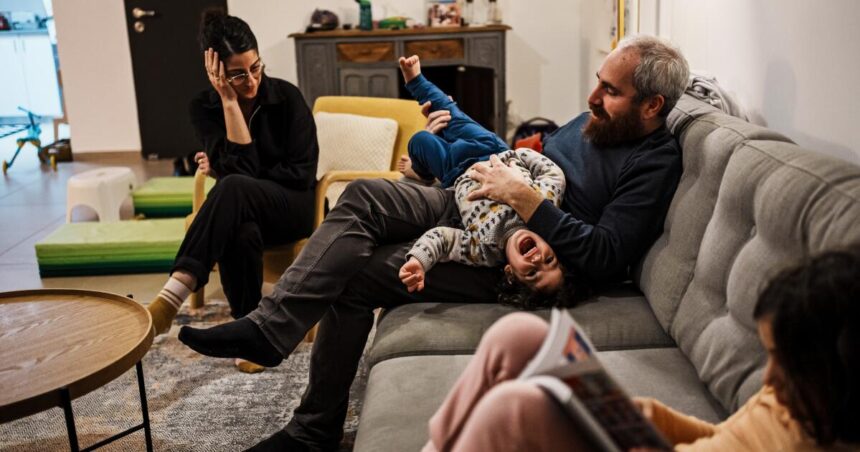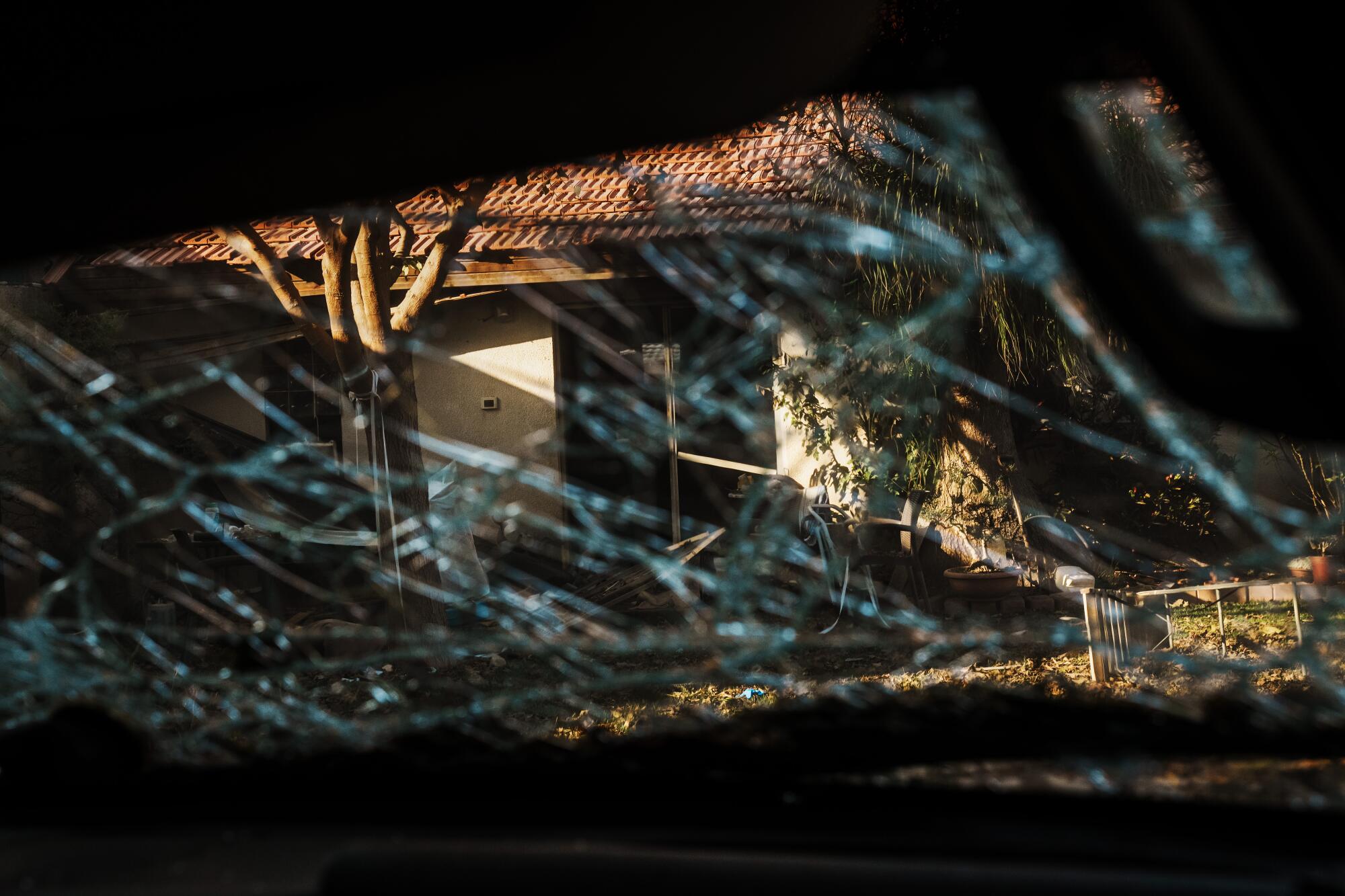Carmel Neta was on the phone with his mother, Adrienne, when Hamas militants stormed her kibbutz on the morning of Oct. 7. He could hear panic in her voice and screams in the distance.
Neta, 39, did his best to calm her, urging her to take refuge in a safe room and then guiding her in a meditation. Two of his siblings were also on the call, and promised their mom that when the attack was over, they would all travel together to Paris.
They were still on the line as the assailants burst into Adrienne’s home. They heard her plead with the intruders in Arabic, which she had picked up while working as a midwife for Palestinian and Bedouin families in southern Israel. Then the call cut out.
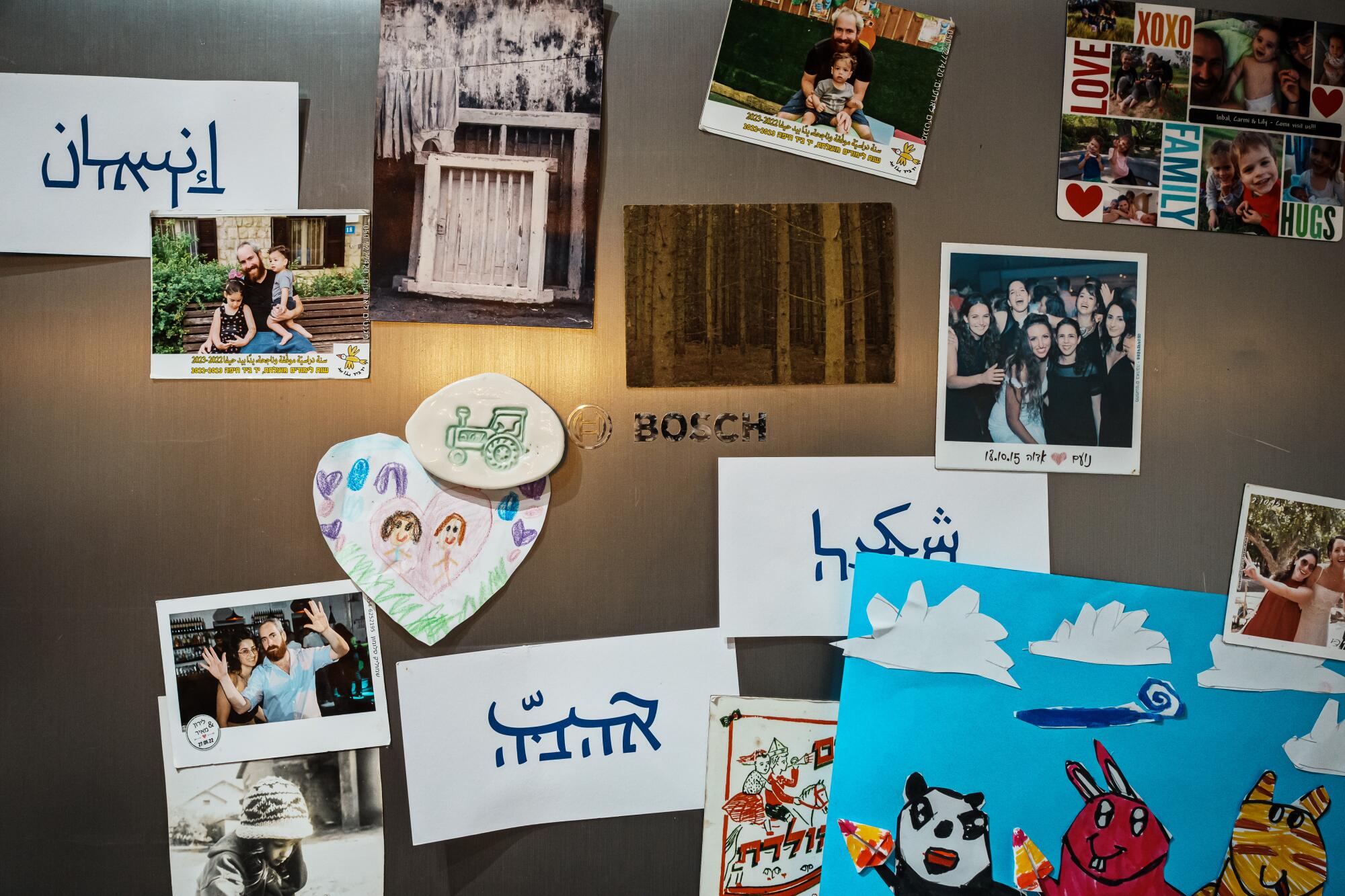
A burned-out house, top, in Kibbutz Beeri, Israel, after the Oct. 7, 2023, attack by Hamas militants. Above, words of affirmation in both Arabic and Hebrew are seen on the refrigerator of Carmel Neta’s home in Haifa, Israel.
Adrienne, 66, died in the massacre at Kibbutz Beeri — one of about 1,200 people killed across the country that day in the deadliest attack in Israel’s history.
In the months that followed, angst and anger flared. Tensions between Jewish and Palestinian citizens of Israel simmered and support for a two-state-solution plummeted. As more than 300,000 army reservists were called up for duty and Israel launched a punishing campaign in Gaza, a grim, wartime mentality took hold.
Carmel knew it all would have pained his mother.
A native Californian, Adrienne believed different cultures could and should coexist. She had raised her four children to respect Palestinians, and had been deeply moved when Carmel and his wife had enrolled their two young children in an experimental bilingual school in which students from diverse backgrounds learned together in Hebrew and Arabic.
And so, after her death, Carmel tried not to get angry. He did not seek revenge. To honor his mother, he drew closer to his Palestinian neighbors and the school. During a bleak time, the school was a source of light — and hope. If schoolchildren could get along, couldn’t the adults do so too?
Adrienne Neta was of hearty Irish stock, with light skin and a mass of fiery red hair.
She grew up in California and was a skilled flutist and violinist, performing with the California Philharmonic Orchestra. At 21, she fell in love with an Israeli man who was traveling across the U.S. after finishing his compulsory military service. Soon after, she followed him back to Israel, to his home in Beeri.
Be’eri had been established in 1946, two years before the founding of the state of Israel, by secular Zionists inspired by the socialist ideal of communal living. The kibbutz was centered on a sprawling collective farm and printing press, and all residents were expected to pitch in.
Adrienne took happily to kibbutz life. She loved being crouched in the dirt for hours, tending to vegetables, and the way families looked after one another’s children. Residents walked around barefoot. Few had locks on their doors.
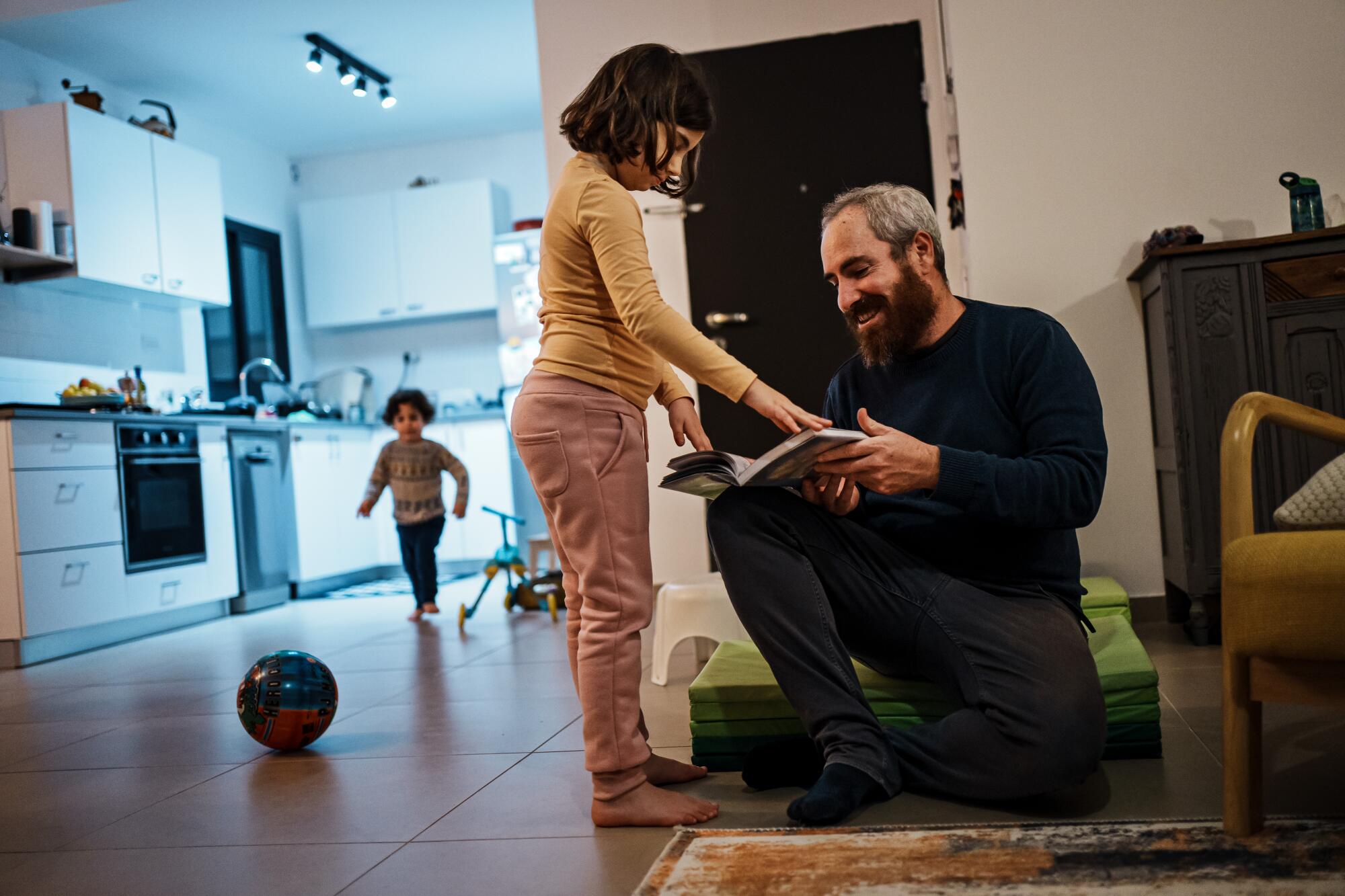
Carmel Neta reads with daughter Lily, 7, while son Dror, 2, plays in the background at home in Haifa, Israel, on Jan. 22, 2024.
Beeri lies just a few miles from the Gaza Strip, and for many years before 2007 — when Israel and Egypt imposed a blockade on the enclave — Palestinians would commute to the kibbutz to work.
Adrienne was always friendly with the Palestinian workers, Carmel said, and with the Bedouin and Palestinian families whose babies she delivered while working at a hospital in the Negev desert. “She was known as someone who treated everyone as a human being,” he said.
Carmel, the second oldest son, had inherited Adrienne’s red hair and blue eyes, and many of her political beliefs.
After serving in the army in the occupied West Bank, where he grew increasingly uncomfortable with the brusque way soldiers treated Palestinians, he returned to the kibbutz with new eyes.
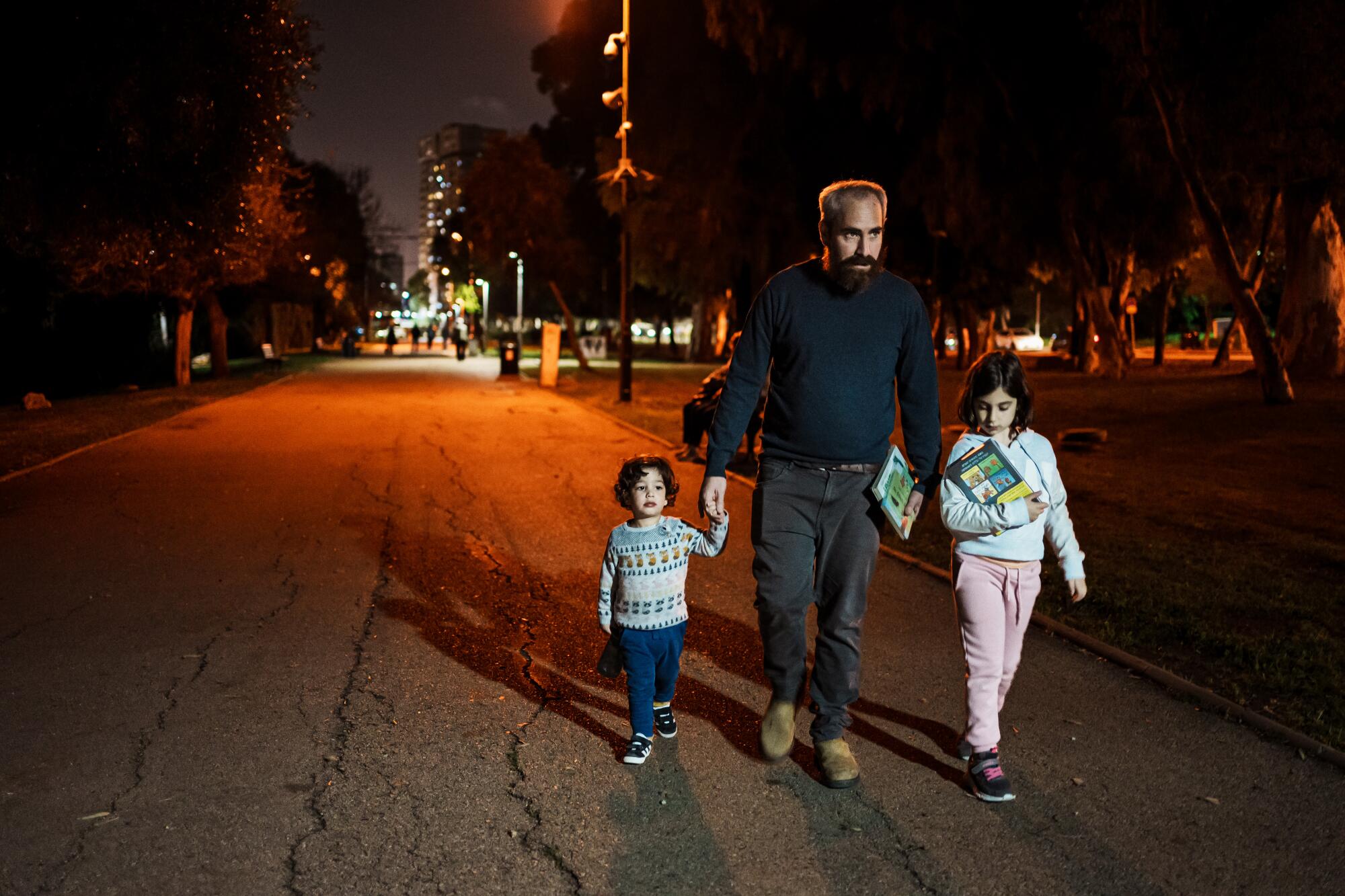
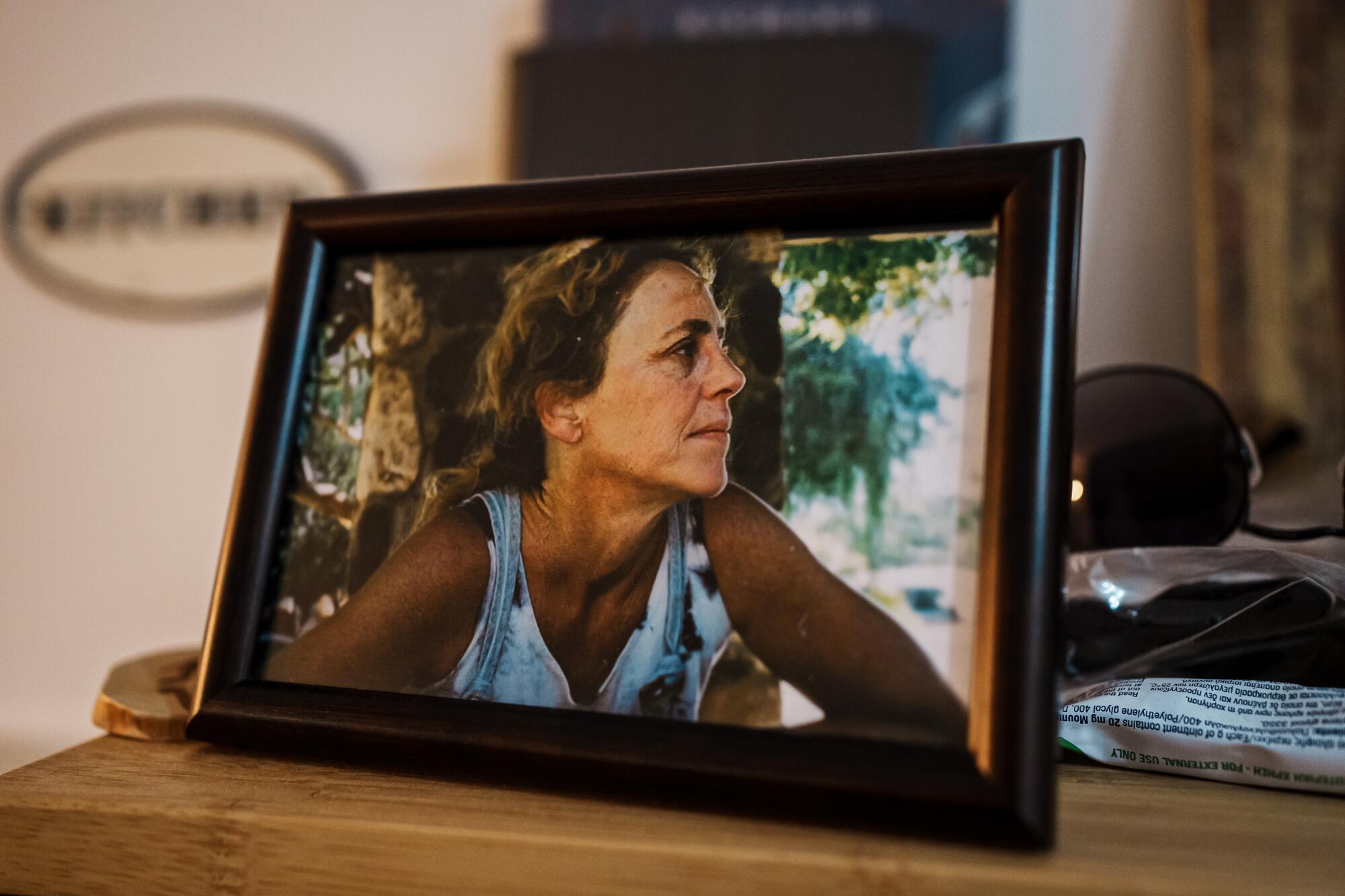
Top, Carmel Neta walks son Dror, 2, and daughter Lily, 7, to the public library near their home in Haifa, Israel. His mother, Adrienne, 66, a native Californian, above, was killed in the Oct. 7, 2023, Hamas attack on Kibbutz Beeri.
“It was a paradise to live in,” he said of Beeri. “But 2 kilometers away you see a fence, and you know it’s hell on the other side.”
The kibbutz was an experiment in radical living, but only for Jewish Israelis, he felt. “What kind of movement is it if there are no Arabs?” Carmel wondered.
Along with his wife, Inbal, 36, whom he had met while she was teaching at a school in Beeri, he decided to move to Haifa, a tech hub two hours north that is known as one of Israel’s most ethnically mixed cities. The couple wanted children, and wanted to raise them alongside Palestinians.
On a recent morning, an 8-year-old girl stood in a sunlit classroom, giving a presentation on the history of chocolate. She swerved between languages, speaking in Hebrew while she described chocolate’s origins, then switching to Arabic when she used numbers. When she finished, her classmates showered her with a chorus of thank yous — “sucran” in Arabic, “toda” in Hebrew.
Pre-university education in Israel is largely segregated, with Jews and Palestinian Christians and Muslims almost exclusively attending separate schools. But in 1998, two educators — one Palestinian, one Israeli — founded a network of schools that would do things very differently.
At the Hand in Hand school in Haifa and five sister schools around the country, a diverse mix of students study in both Hebrew and Arabic. Each class is taught by two teachers — one Palestinian, and the other Jewish. The curriculum includes lessons on the Holocaust as well as the Nakba, the mass displacement of Palestinians during the 1948 creation of Israel.
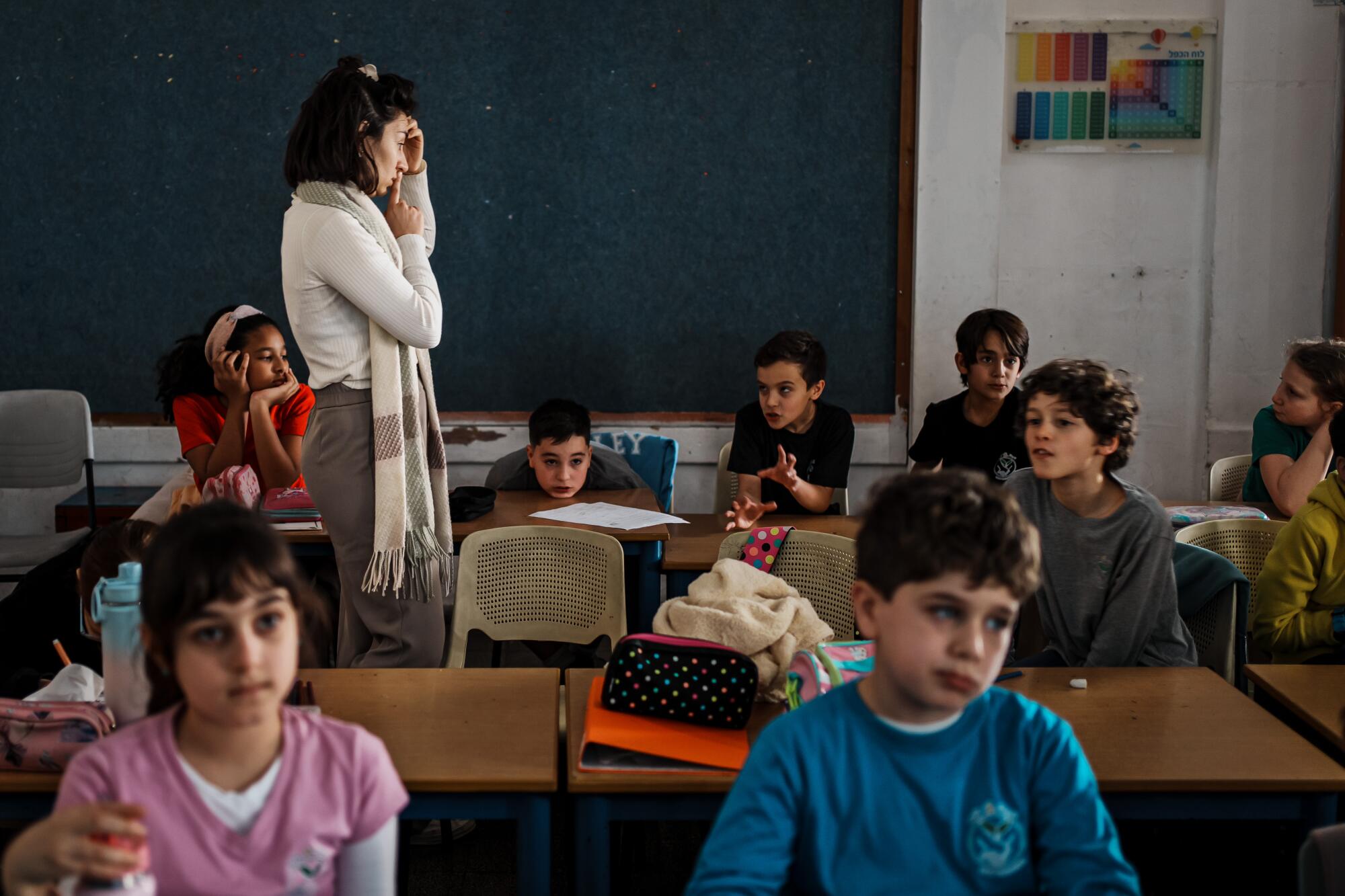
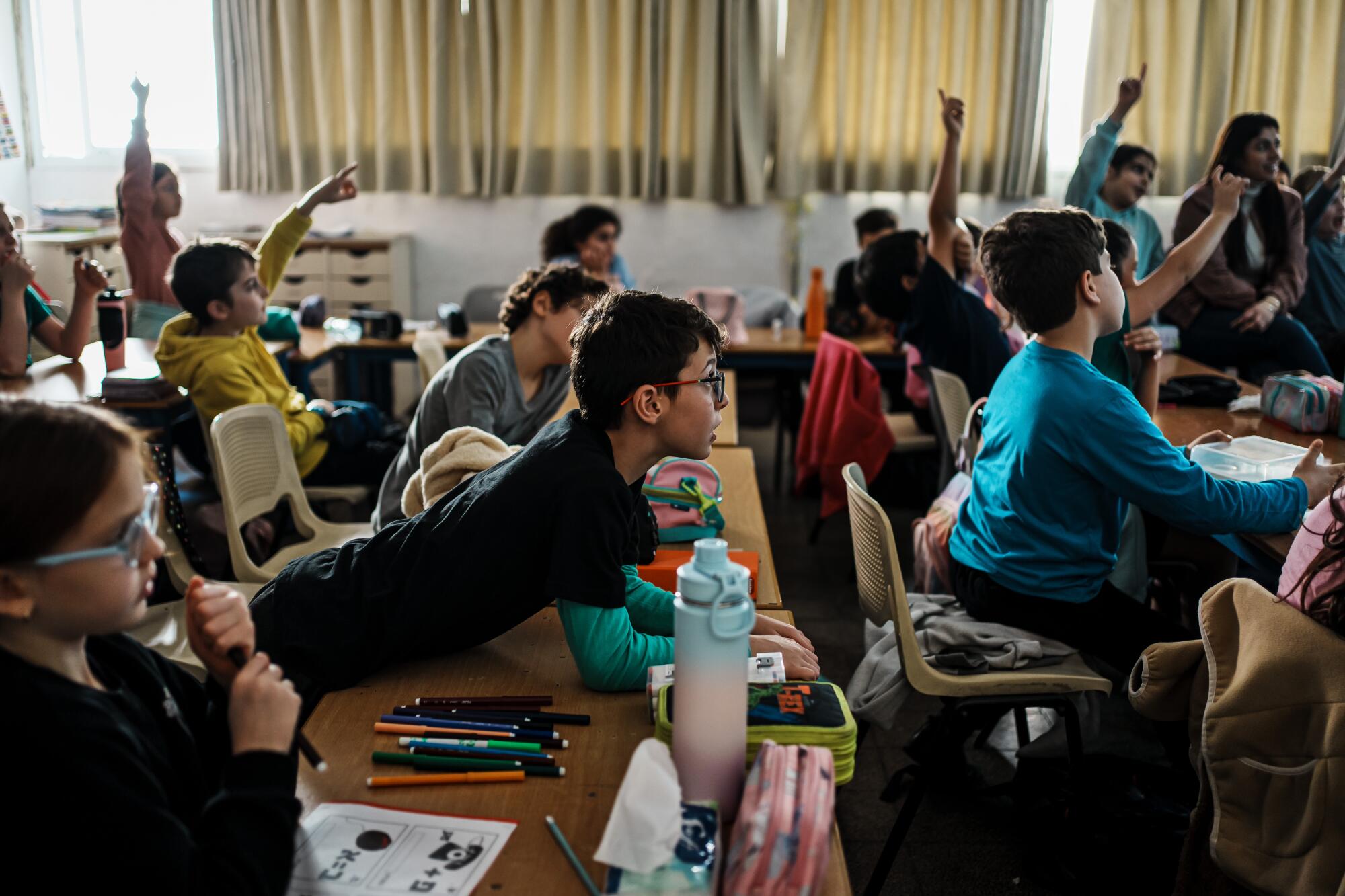
Top, a teaching staff member helps students focus during classroom presentations at the Hand in Hand school in Haifa, Israel. Students, above, participate in class at the school, where a diverse mix of pupils study in both Hebrew and Arabic.
About six years ago, Inbal began teaching at Haifa’s branch of Hand in Hand, and she and Carmel enrolled their toddler Lily in the pre-kindergarten program.
Lily immediately took to Arabic. Carmel often sent videos of her babbling in the language — or singing songs side by side with Palestinian classmates — to his mother, who cried tears of pride. “She was really into it,” he said. Sometimes they discussed what it meant that such scenes were rare in Israel.
Carmel had learned some Arabic while in the army. “But it was the Arabic of the occupation,” he said. “You learn to shout into a microphone: ‘Get out of the house, you are surrounded.’ Or: ‘Get out of the car.’”
Through Lily and his 2-year-old son, Dror, who began school last year, he has acquired a wider, and gentler, vocabulary.
The school’s mission was always to reach parents, not just their children. It invited them on community camping trips, Haifa history tours and to parties to mark holidays including Easter, Passover and Ramadan.
A few years ago, Carmel participated in a series of dialogue sessions, where, over the course of several months, parents shared their personal histories. Sometimes the conversations became tense as they veered into politics. But people ultimately found common ground.
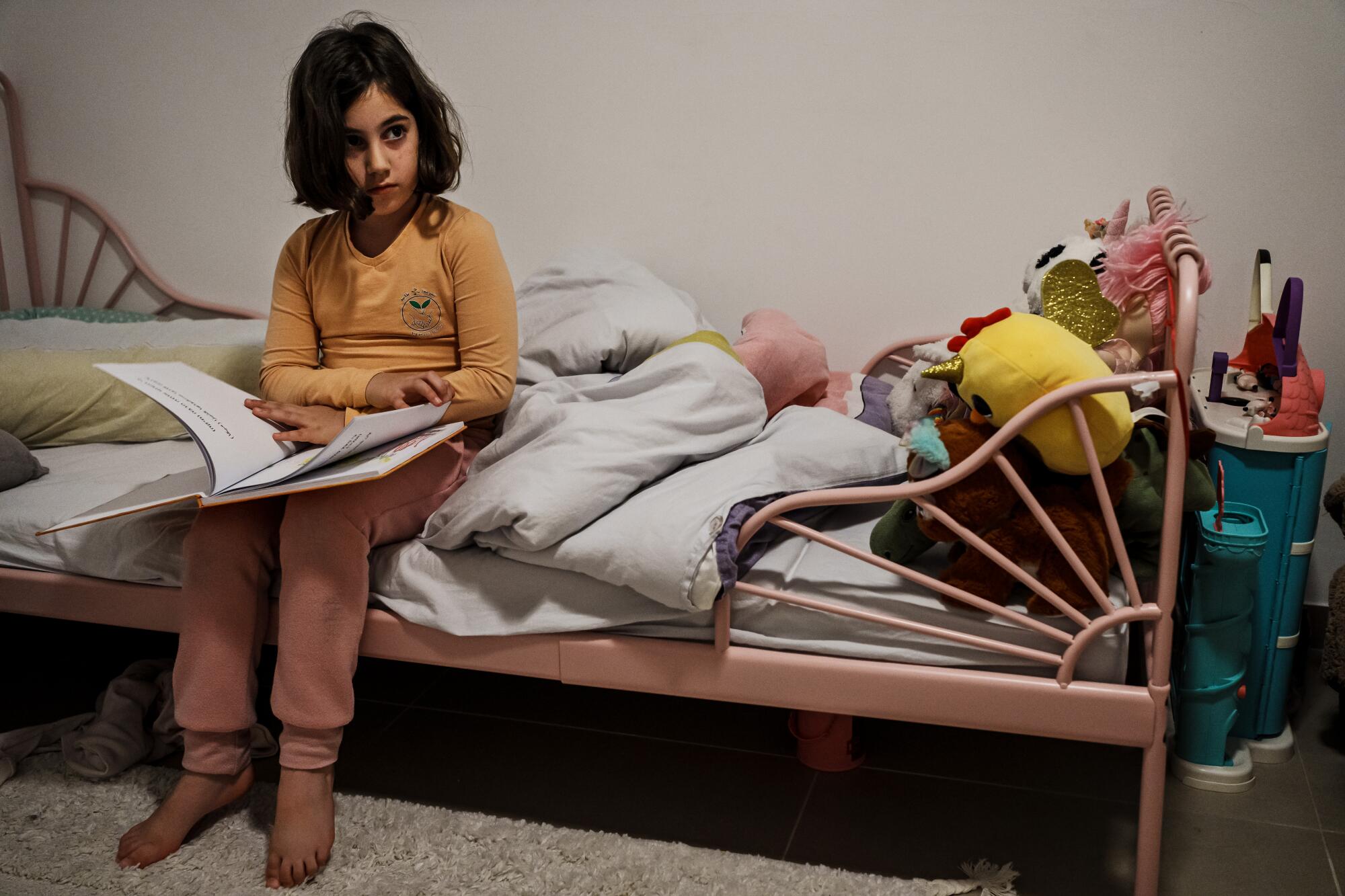
Lily Neta, 7, reads her bilingual children’s book at home in Haifa, Israel.
“Everyone is so different,” Carmel said. “I come from a kibbutz. Others grew up in Arab villages outside of Nazareth. But it always comes back to the kids and our hopes for the future. It’s very different stories starting from very different points, but you see these lines coming together.”
It was a bold experiment in a country that for years had been moving to the right. Still, no one was prepared for the test that was about to come.
For several days in the wake of Oct. 7, Carmel and his siblings didn’t know what had happened to their mother after the call dropped. They held on to a grotesque hope: that she had been taken hostage.
But eventually, officials confirmed it: She was dead.
Carmel and his siblings went into mourning. For their mother, for their friends who had been killed or taken hostage and for the kibbutz itself, which had been largely destroyed by flames and fighting. “I’m grieving for my mother and for the place I grew up,” Carmel said. “My story, my history, has been wiped out.”
But he was acutely aware of how his pain fit into a larger patchwork of suffering.
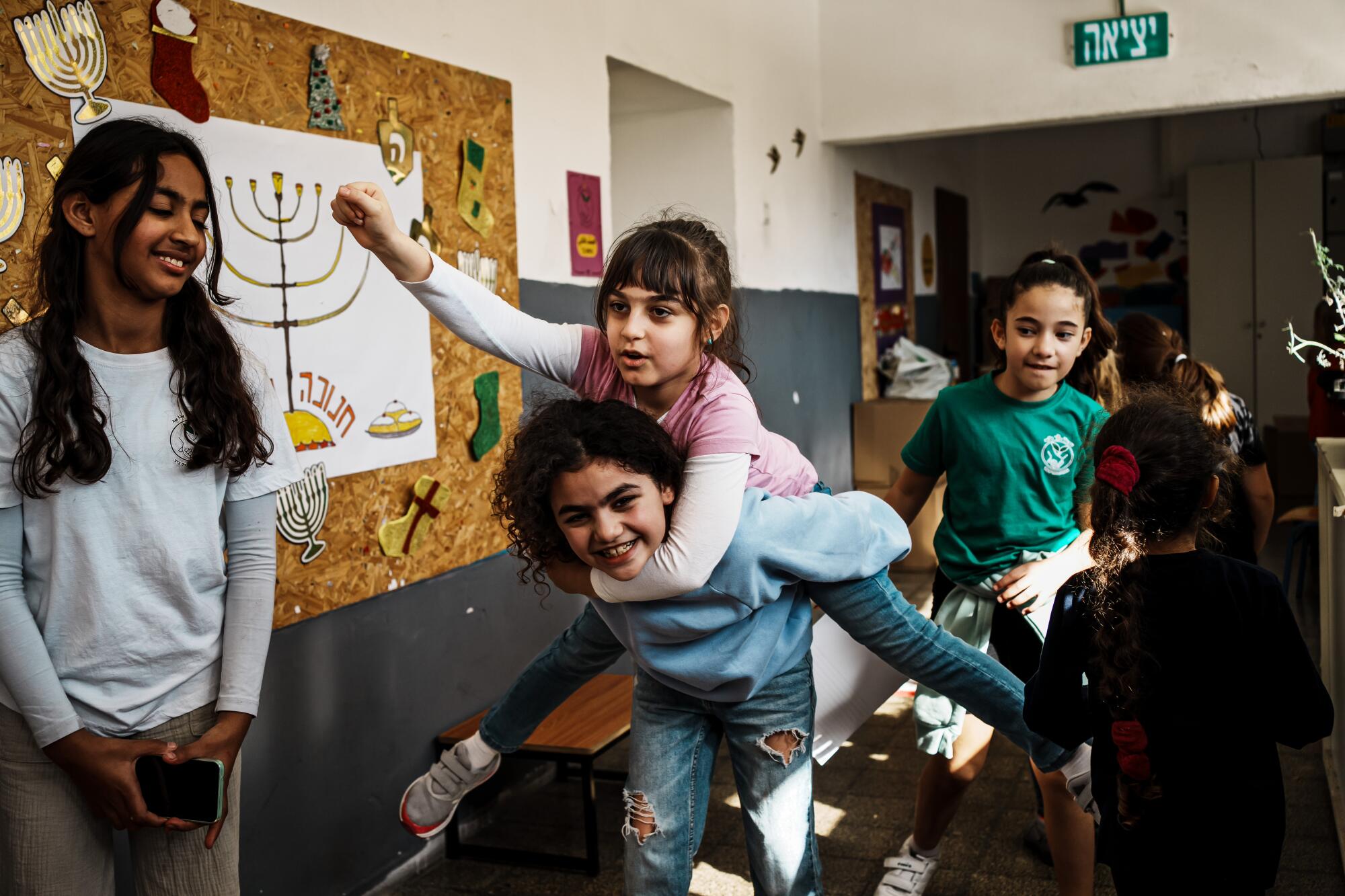
Students play in the hallways during recess at the Hand in Hand school in Haifa, Israel.
He thought about parents who have lost children on both sides of the conflict. He thought about starvation in the Gaza Strip. “Yes, I’m here with my tragedy,” he said. “But there are people without anything to drink or eat.”
For the Hand in Hand community in Haifa, the events of Oct. 7 and the subsequent war were paralyzing at first. Jewish Israeli families felt their sense of safety had been shattered. Palestinians were horrified by the Hamas attacks, but also bothered by the sense that they were expected to condemn them, and afraid of Israel’s response to come.
“It was a feeling of grief. Of awkwardness,” said Safi Mansour, a Palestinian citizen of Israel who helped found Hand in Hand’s Haifa branch. “People were overly careful talking to each other. Everyone was hesitant.”
The school hosted a series of conversation circles for parents that were often very tense. There were lots of tears. Sometimes raised voices.
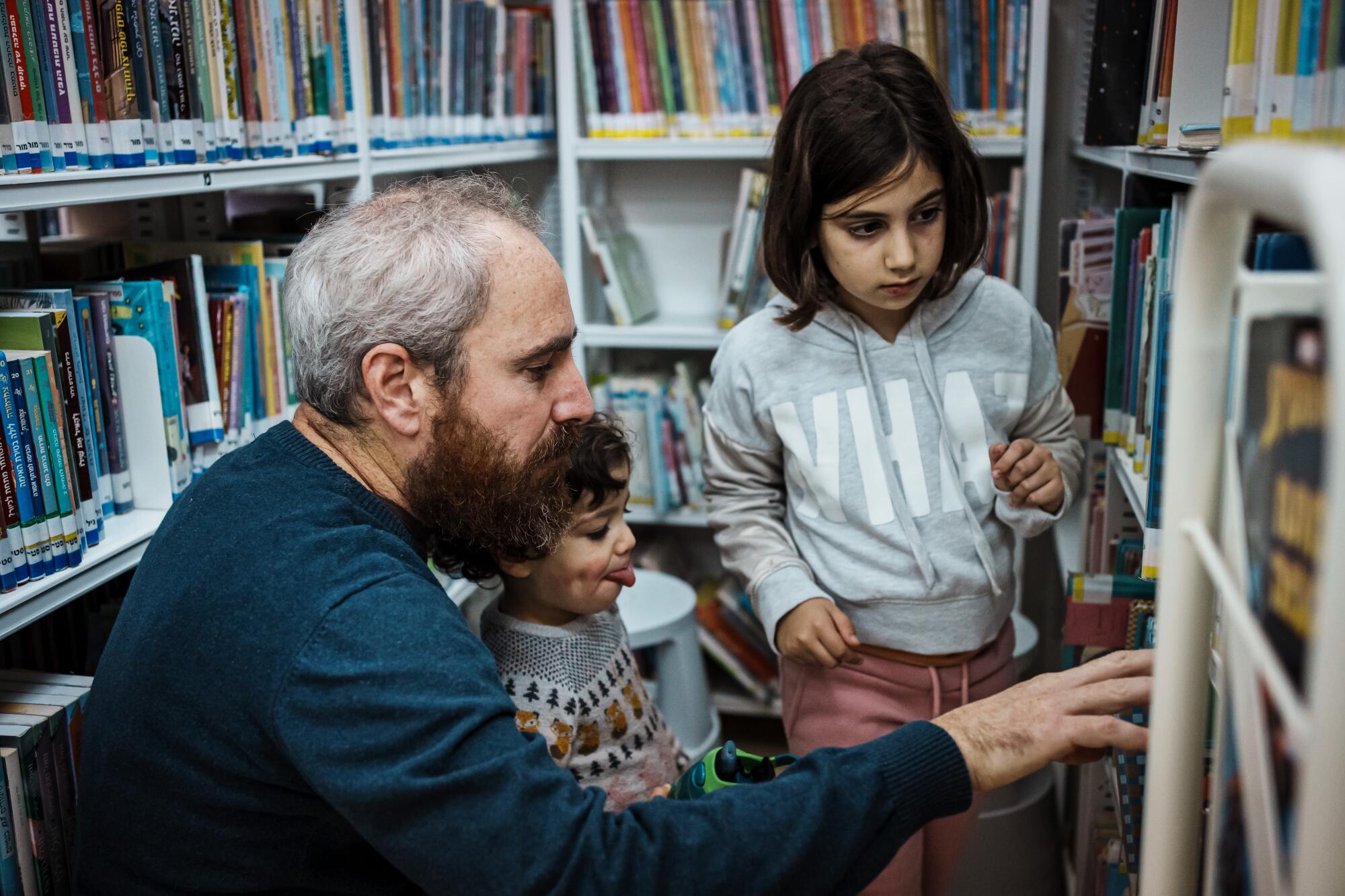
Carmel Neta helps son Dror, 2, and daughter Lily, 7, pick out books to borrow at the library near their home in Haifa, Israel.
But the meetings revealed something else. All of the school’s parents, regardless of their background, faced similar issues: the fear of a wider war and the challenge of how to explain what was happening to their children.
Rebecca Sullum, a community organizer for the school, said the community was brought together by a simple question: “What’s it like to parent kids right now?”
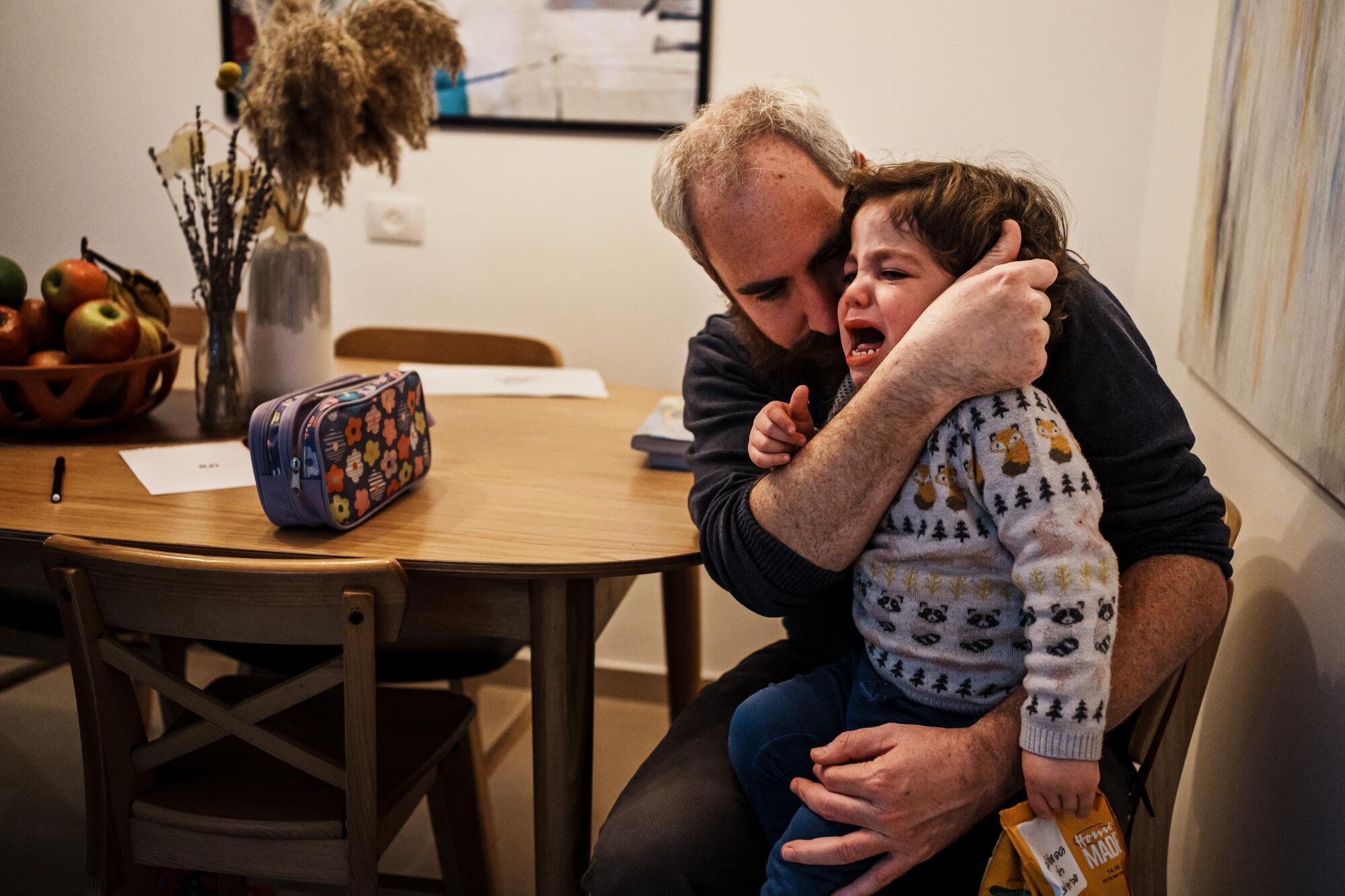
Carmel Neta tries to calm son Dror, 2, at their home in Haifa, Israel.
For Carmel and Inbal, it has not been easy. They assure their kids that they are safe, even as rocket sirens wail, telling them the war is between good people and bad people. They make it clear, though, that they’re not talking about Israelis versus Palestinians.
“I don’t see the Gazan people as my enemy,” Carmel said. “I see their leaders and my leaders as the enemy.”
Parents from the school have become an important support network for Carmel’s family since Oct. 7. He grew closer to the Palestinian father of a child in Lily’s grade. This spring, the friendship blossomed into a business partnership. The men are launching a startup together.
The war has hardened many people, including Carmel’s father, who is alive because he happened to be visiting Carmel in Haifa on Oct. 7. He recently moved back to Beeri and is one of only a handful of people living there.
“He doesn’t see any path to peace,” Carmel said. “He is angry at the Palestinian people.”
Like many Israelis, his father is also frustrated with his government.
Carmel, who shares that anger, recently attended a protest against Prime Minister Benjamin Netanyahu in Jerusalem. It was gutting, he said. He kept having the urge to send photos of the action to his mother, who last year participated often in protests against Netanyahu’s planned judicial reform. Carmel had hoped that his grief would have evolved by now, six months after his mother’s death. “But it feels like this is life now.”
Some of Carmel’s friends have fled the country — mostly for Europe. He and Inbal have discussed following them. His grandfather’s family left Europe ahead of the Holocaust. Sometimes he wonders: “How did they know when to leave? How did they decide, ‘This place cannot be changed and we need to migrate?’”
But he knows his mother would have wanted him and his siblings to stay and fight to make Israel better.
“I think she would ask me why I’m still working … and not doing more,” he said. He has a friend — the son of a slain peace activist — who quit his job to devote himself full time to calling for peace. Recently he spoke to members of the Haifa Hand in Hand community.
After the death of his mother was confirmed, Carmel’s family began preparing for shiva, the Jewish ritual of mourning.
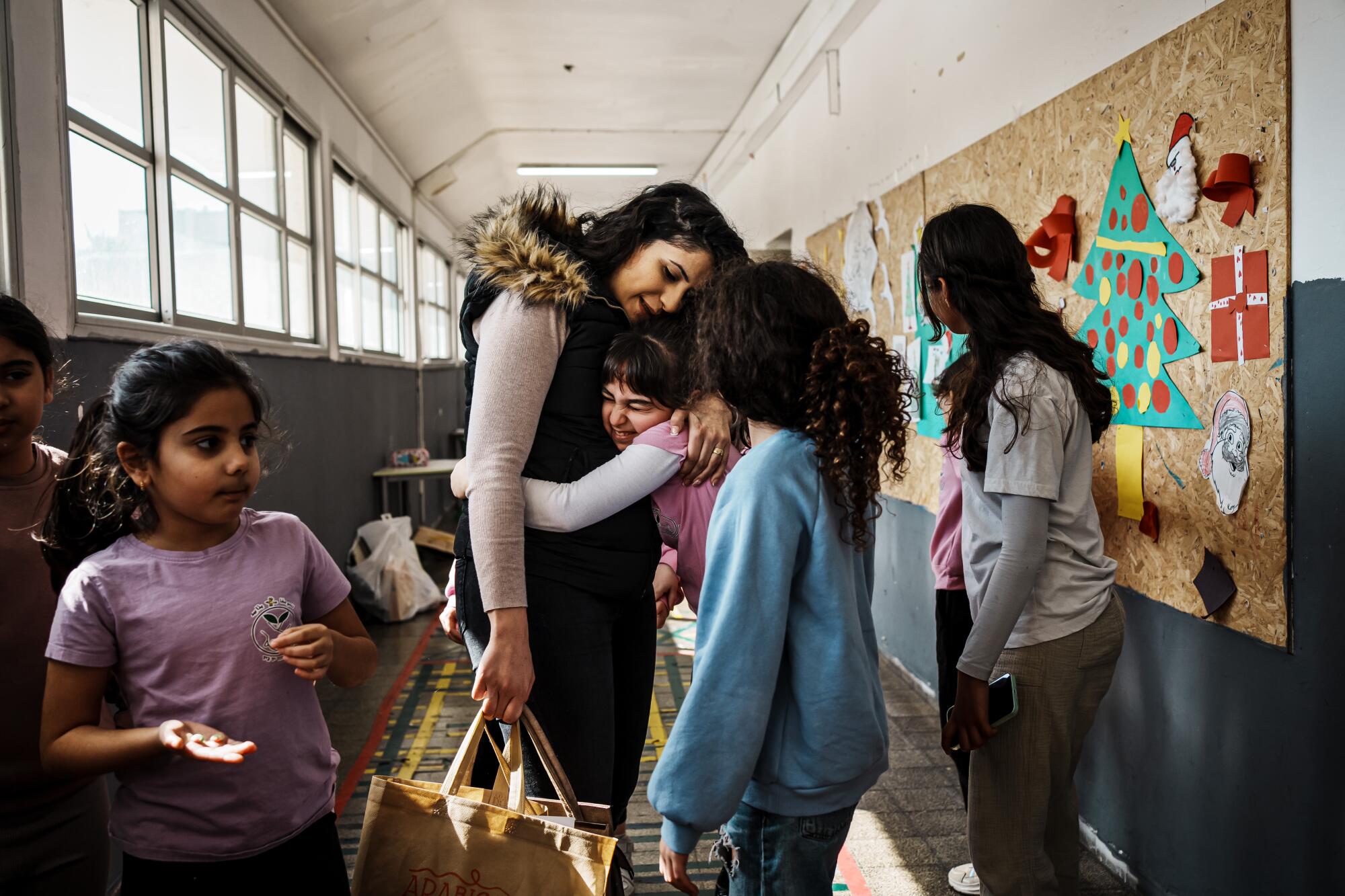
Laila Agini, a teacher, greets a student during recess at the Hand in Hand school in Haifa, Israel.
As word spread about Adrienne, many Palestinian community members felt an urge to attend her shiva, but weren’t sure they’d be welcome. They asked community leaders such as Sullum: “Do people want us there? Because if there’s even one person who doesn’t want us, we won’t go.”
Carmel’s response was immediate: “Of course.”
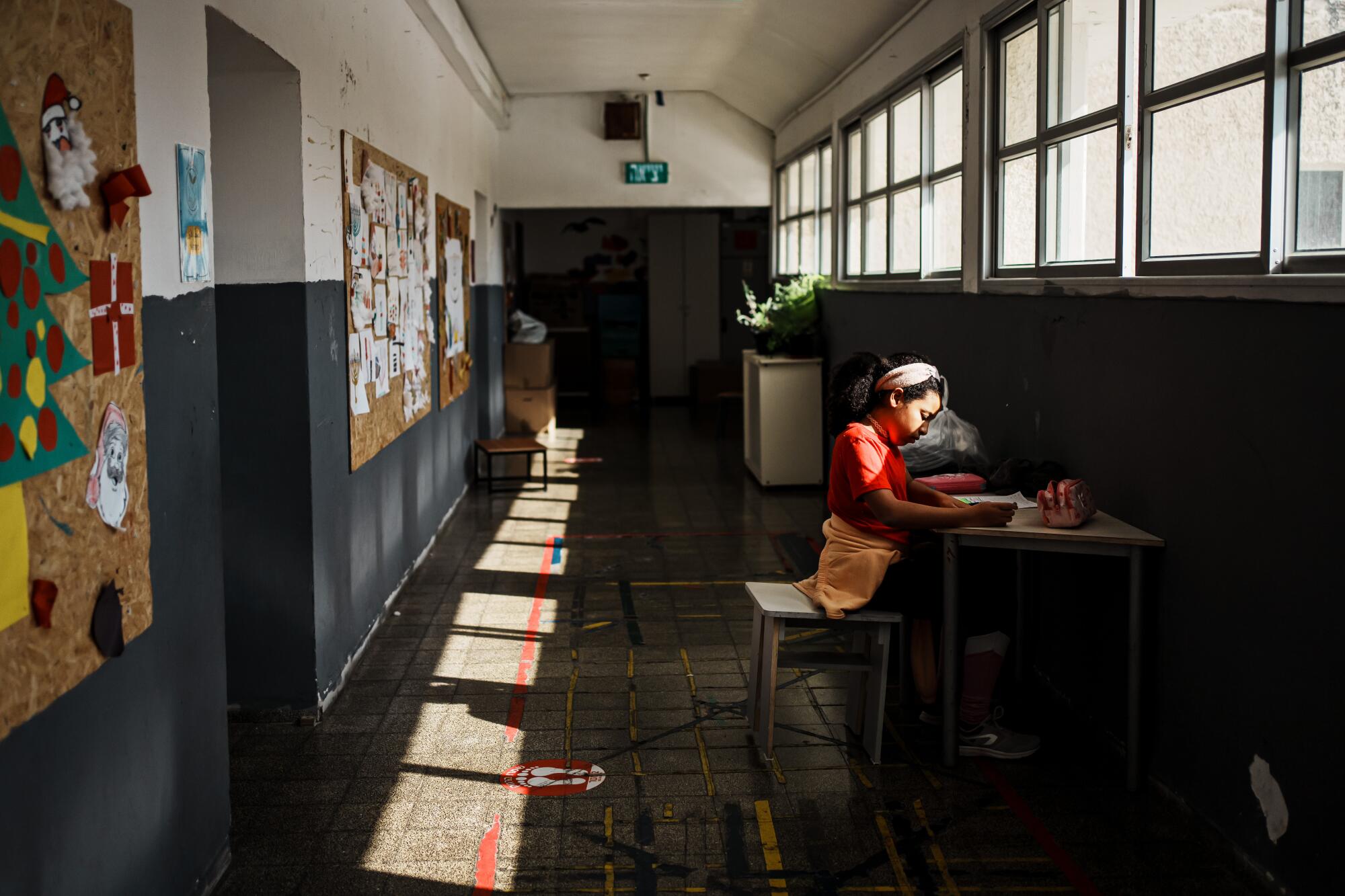
A young student works on an assignment in between classes at the Hand in Hand school in Haifa, Israel.
“My mother dedicated her life to bringing life into this world and seeing people as equals,” he told Sullum and many of the dozens of families who ended up coming to the shiva. “Everyone’s welcome here.”
The ceremony was held at a family home with an ample backyard. Inside, the parents talked and mourned and wept, together. Outside, the children played.
